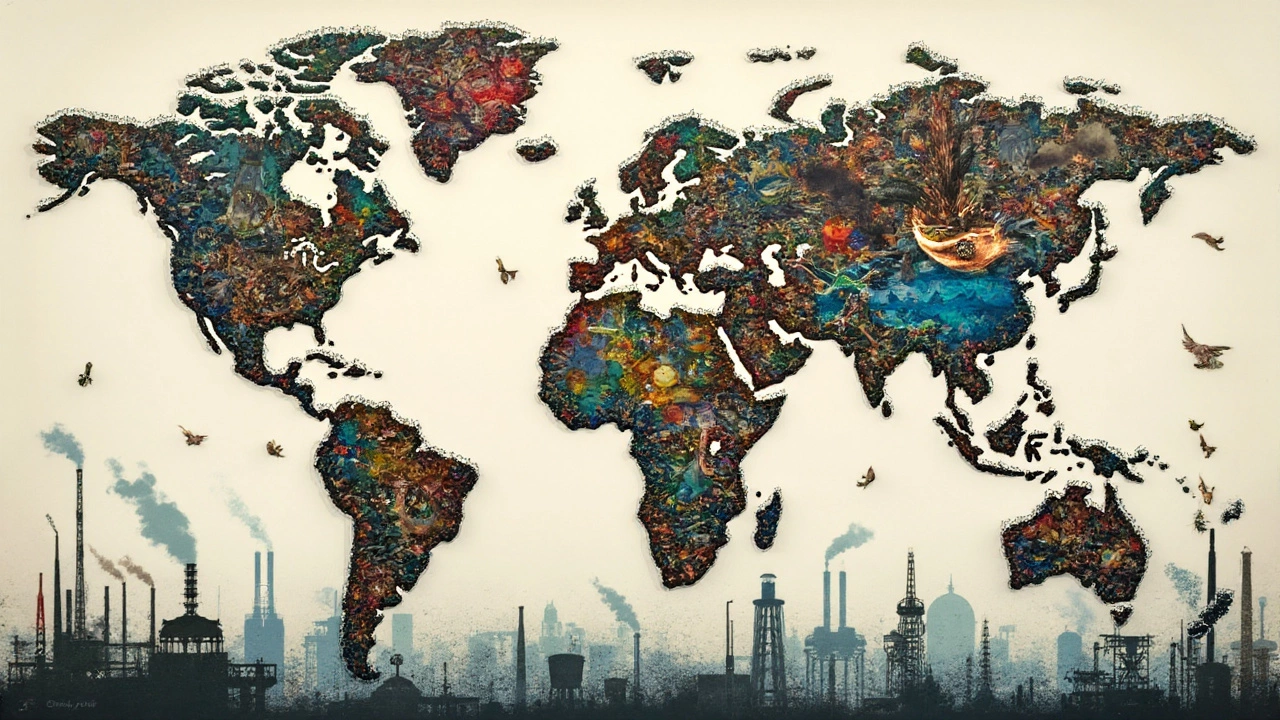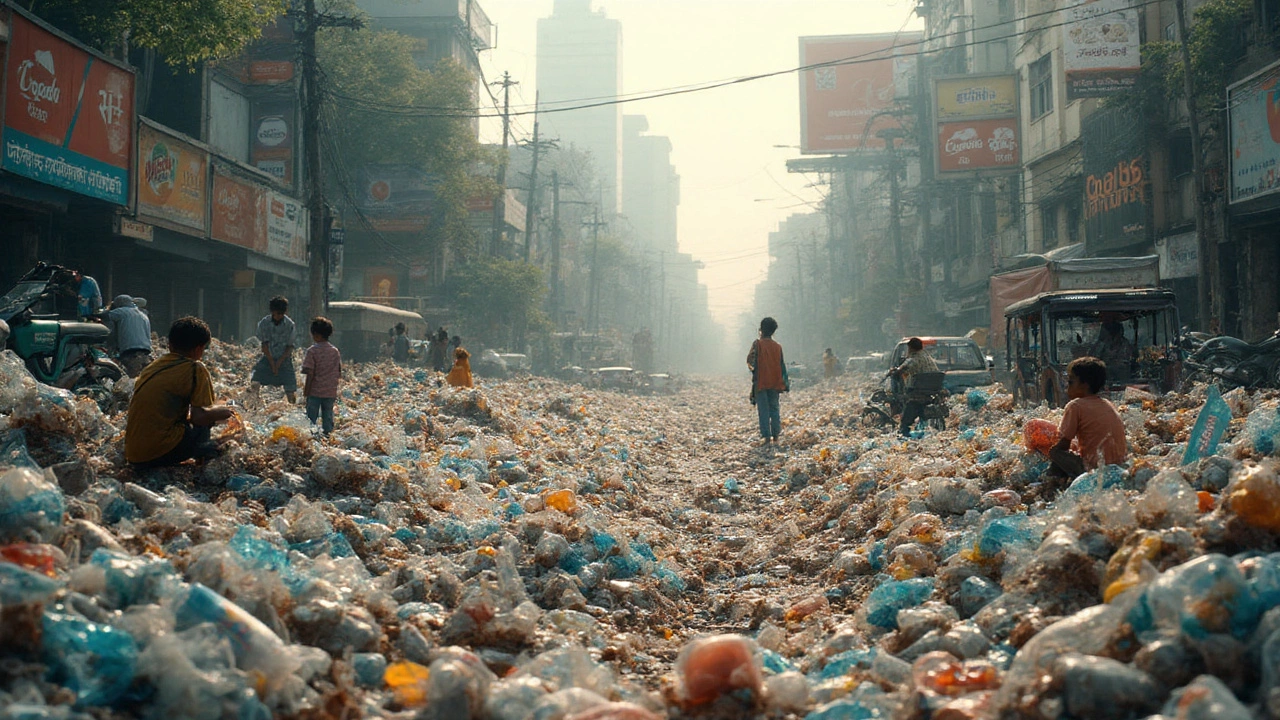Ever wonder whose hands are really the stickiest when it comes to tossing away plastic? We hear about oceans drowning in bottles and turtles tangled in bags, but rarely do we get actual numbers—or the real culprits. The world makes mountains of plastic, but some countries and companies seem to race each other to see who can turn out the most waste. It isn’t always who you’d think, either. Let’s cut through the romantic talk about recycling and get into the nitty-gritty—just who is responsible for the mess, how they got there, and what’s being done about it. Ready to see where your daily packaging fits into a global pile-up?
The Plastic Waste Champions: Countries That Top the Charts
Look at a map of plastic villains, and you might expect the richest countries to lead the way. But the real story is a mix of predictable and surprising names. Let’s talk numbers. According to the 2024 Plastic Waste Makers Index, the world churned out around 460 million tons of plastic each year. China leads, no contest, producing and also discarding the most plastic—more than 60 million tons of plastic waste in a single year. The United States, even with fewer people, comes close behind with almost 40 million tons of waste each year, and it’s the king of plastic waste per person. Every American tosses the equivalent of about 130 kilos of plastic every single year—that’s like throwing away two heavy gym bags completely filled with plastic, just for one person.
But what about Europe, India, or those “zero-waste” Scandinavians? The European Union as a whole is no angel—EU nations combine for about 30 million tons of plastic waste annually. India, with its giant population, throws out a ton too, but with lower rates per person, sitting somewhere near 11 kilos per head per year. But here’s a shocker: countries like Indonesia, the Philippines, and Vietnam don’t produce the most plastic, but they dump some of the largest amounts straight into the ocean because of weak waste systems—another reminder it’s not just about how much you use, but what you do with it afterward.
Want to see how these numbers stack up? Here’s a handy quick-glance:
| Country | Plastic Waste Generated (Million Tons, 2024) | Plastic Waste per Person (Kg/Year) |
|---|---|---|
| China | 60+ | 43 |
| USA | 39 | 130 |
| EU (28 countries) | 30 | 66 |
| India | 25 | 11 |
| Indonesia | 10 | 37 |
What’s with the U.S. being so high per person? A lot comes down to single-use packaging, fast food culture, and, let’s be honest, how little actually gets recycled in North America compared to Europe or Japan. Even more shocking: Only about 6% of U.S. plastic waste actually gets recycled. The rest heads to landfill, incinerators—or gets shipped abroad, where it rarely lands in a proper recycling facility.
Who Makes It All? The Plastic Manufacturing Industry’s Surprise Players
Not all plastic is created equal, and not every country or company trashes the same kind. The plastic manufacturing industry is a giant, and a handful of big players set the pace. ExxonMobil, Sinopec (from China), and Dow together make nearly a fifth of all single-use plastic produced worldwide. So even if you aren’t driving an Exxon-powered car, your shampoo or snack wrap probably started there.
Here’s a twist most people miss: developing nations (like Indonesia or Vietnam) don’t actually produce much plastic themselves. Most of what piles up on their shores was made—and used—in rich countries, then shipped overseas as “recyclables” or just plain garbage. In 2022, a report by The Guardian found that more than 40% of plastics marked as “recycled” on U.S. packaging were actually shipped to Asia, where only a fraction got recycled. The rest? Burned, buried, or washed out to sea.
Think about packaging. Just 20 companies make more than half of all the world’s single-use plastic waste, and almost all are in the oil and chemical industry. These same companies have been accused of confusing consumers, funding recycling programs they know can’t keep up with the waste. The recycling symbol on plastic? Big manufacturers pushed for it in the ’80s, but even today, most people can’t actually recycle the stuff locally. According to the Plastic Waste Makers Index 2024, over 130 million metric tons of single-use plastic packaging went straight to waste in the previous year—almost none of it recycled.
Sometimes big brands are called out, too. Coca-Cola, PepsiCo, and Nestlé keep topping lists of the “most polluting” companies when volunteer beach cleanups dig through the trash. Their plastic bottles and snack wrappers turn up almost everywhere, from the banks of the Ganges to the beaches of California. A Greenpeace audit in 2023 listed these three as the worst plastic polluters for the fourth year running.
“Only about 9% of all plastic waste ever produced has been recycled, the rest has ended up in landfills, dumps, or the natural environment.” — National Geographic
So, next time you hold a disposable coffee cup, think about where it came from and where it’s headed. Odds are, it was made by one of about two dozen companies scattered between Houston, Rotterdam, and Shanghai.

Plastic Pollution in Action: Oceans, Landfills, and What Actually Happens
It’s one thing to talk about “waste,” but where does all that plastic actually end up? Shocking truth: Around 13 million tons of plastic slides into the ocean each year. By 2050, some experts warn there could be more plastic (by weight) in the sea than fish. And not just the big bottles you see in viral turtle videos—microplastics, the tiny shreds of bottles, bags, and clothing, are showing up in fish, shellfish, rainwater, and—in 2025—human blood and lungs. Yikes.
Landfills are bursting, too. In rich countries, most plastic just gets buried. In the U.S., about 75% of all plastic waste goes straight to landfill. Landfill sites overflow, leaching chemicals into nearby water and soil. And if you burn plastic, as they do in parts of Asia or Africa, you trade away clean views for clouds of toxic smoke—lots of dioxins and heavy metals spew up.
Let’s zoom in on ocean plastics for a second. The Great Pacific Garbage Patch—maybe you’ve heard of it—spans an area twice the size of Texas. It’s not an “island” of trash, but more like a plastic soup, with everything from ghost fishing nets to microbeads from your toothpaste. According to a 2024 estimate, over 80% of ocean plastic spills out of just 10 rivers—eight in Asia, two in Africa. These rivers act like plastic conveyor belts, fed by big cities with weak trash collection, shipping the waste straight to open water. The Yangtze, Ganges, and Niger Rivers are the biggest offenders.
On land, the problem’s closer than you think. Recent studies found American farmland now contains hundreds of millions of microplastic particles per acre, mostly from sewage sludge used as fertilizer. Researchers at the University of Manchester in 2023 discovered microplastics buried in UK mountain soils, probably carried by wind and rain from hundreds of miles away. The stuff never goes away—it just breaks into smaller bits.
Here’s a small table to break down the fate of global plastic waste:
| Destination | Share of Global Plastic Waste (%) |
|---|---|
| Landfill | ~50 |
| Incineration | ~20 |
| Recycled | ~9 |
| Leaked to environment (land/sea) | ~21 |
It’s a vicious cycle. Cities and companies make the stuff, consumers use it for minutes, and it sticks around for hundreds, maybe thousands, of years. A single plastic straw used at lunch today could easily survive until the year 2500.
Tips to Waste Less (Without Driving Yourself Crazy)
You can’t solve plastic pollution alone, but you’re not powerless. Start by figuring out where the most waste hides in your routine—spoiler: it’s usually food packaging, shopping bags, water bottles, and bathroom products. Here are some real-life, easy switches that hundreds of people have made work:
- Skip bottled water: A reusable bottle can replace over 150 single-use bottles per year, per person. Tap filters are cheaper than you think.
- Get serious with bags: Stash a foldable tote in your car, bike, or backpack. No more “I forgot it again.”
- Pick products that actually get recycled: In many cities, only #1 and #2 plastics (like soda bottles and milk jugs) truly get recycled. Check your labels.
- Buy bigger packaging: Family-size yogurt tubs make less plastic per serving than little snack cups.
- Refill and recycle: Plenty of supermarkets now let you refill soap, detergent, or oil. Explore what your area offers.
- Pressure your supermarket to cut the wrap: Join or start a petition. If enough shoppers demand it, stores will stock less plastic.
- Support bottle bills: States and countries with deposit returns have much less litter. A 2024 study found German bottle returns at a whopping 98% success rate.
- Tell brands what you think: Use social media. Brands care about their reputation. The squeaky wheel does sometimes get the packaging grease.
If you want to go even further, check out community cleanups—they’re a blast, and you meet people who get how weird and maddening it is to see the same brands wind up in rivers, parks, and gutters. And yes, voting makes a difference—a new UN plastics treaty is in the works, and plastic bans or taxes really do cut waste at the source.
Sometimes it feels like you’re just one drop in a polluted sea, but big change often comes in waves. Don’t let big brands convince you it’s just on your shoulders. Still, if millions of people start pushing back—even a little—it adds up fast. That straw saved, that bottle reused, really does matter, especially when you spread the word.
No one likes a finger-wagging do-gooder, but there’s something pretty satisfying about keeping your own plastic footprint as light as possible, knowing you’re bucking the trend. Who wastes the most plastic? Truth be told, it’s still the biggest countries, the biggest companies, and the most wasteful habits. But it only takes a couple of smart tweaks to make sure you’re not fueling the problem. Who’s with me?
